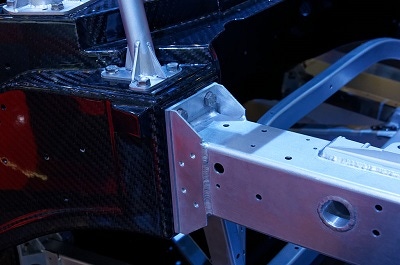Aluminum and high-strength steel will play key roles in vehicles shedding mass in coming years, while carbon fiber composites costs need to be lowered according to speakers at the 6th Global Automotive Lightweight Materials Detroit Summit, which will be held 22-24 August this year.
July 17, 2017

According to Sue Hartfield-Wunsch, Technical Fellow, Body Manufacturing Engineering, at General Motors, the game changers have been electric and hybrid vehicles, both requiring lightweighting to offset the mass of batteries and other components. As to how this lightweighting might be achieved, Hartfield-Wunsch notes that high strength steels, including the new Gen 3 steels, continue to be cost efficient for automotive lightweighting.
|
Aluminum is viewed as a key enabler in vehicle lightweighting, whereas carbon fiber composites costs need to come down according to automakers. The photo shows a combination of carbon fiber composite and aluminum employed in the Alfa Romeo 4C's monocoque chassis. |
“We have also seen a dramatic increase in aluminum castings, extrusions, and sheet use in recent years.,” she adds. “We have implemented six common aluminum grades globally, and continue to work on new grades for improved strength and improved formability.” Carbon fiber composites, meanwhile, offer a lot of promise but they are still cost-prohibitive for wide spread use,” she notes Hartfield-Wunsch will be presenting a case study on how to Understand & Overcome Manufacturing Challenges For Aluminum Sheet In The Automotive Industry at the event.
John Uicker, Chassis Engineering Supervisor, at fellow Big 3 automaker Ford Motor Company concurs with the materials outlook, noting that the next generation of advanced high strength steels and aluminum have the most potential in delivering cost efficient automotive lightweighting. “Carbon fiber needs to become more affordable before it can be used on a large scale,” he adds. Uicker will be presenting a case study on Design And Testing Of A Cast Magnesium Front Subframe at the event.
James Truskin, Technical Fellow for Body-In-White, at the American subsidiary of Fiat Chrysler Automobiles, FCA US LLC, is yet another advocate of metal for shedding weight. “The recent progress made in high strength steel has been significant to driving cost-effective lightweighting solutions. It has allowed a more weight-efficient execution of structures that are critical to improving safety and protecting the occupants in impact events. The improved formability of these newer grades has been important to ensuring they that can be integrated efficiently into a structural component,” he notes
Truskin believes aluminum will also continue to have a place in the industry, especially for larger exterior panels, where the properties of the metal offer great benefits to achieve significant mass reduction and achieve performance targets. He adds, “I am interested to see how far the cost of carbon fiber can be reduced in the next 5-10 years, which would help it become a more cost efficient solution for automotive applications.” Truskin will be a panelist at the event’s session on OEM Material Strategies.
About the Author(s)
You May Also Like





